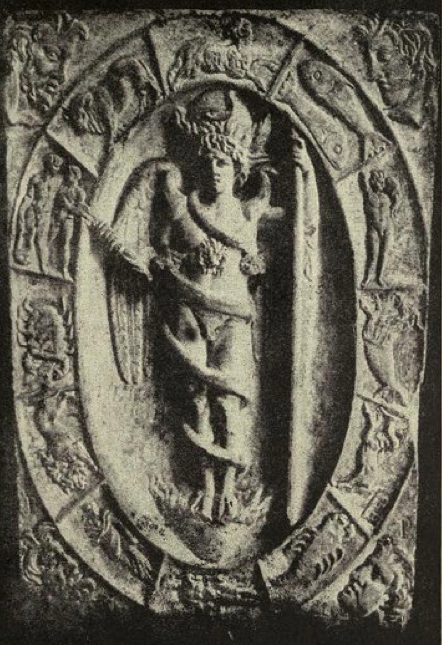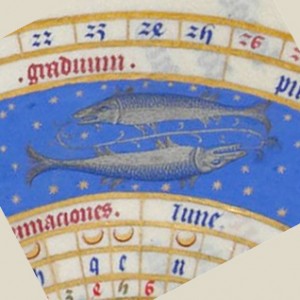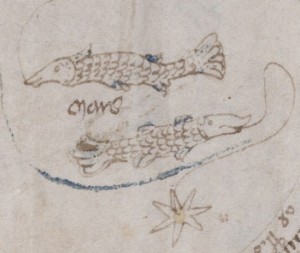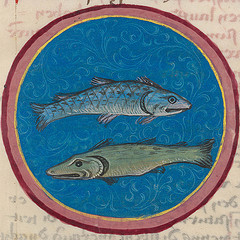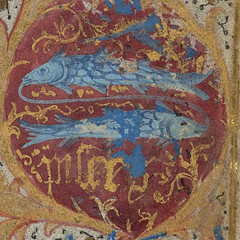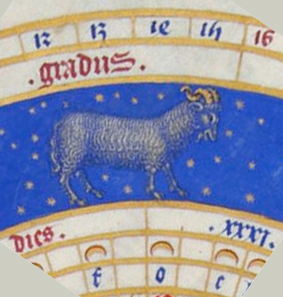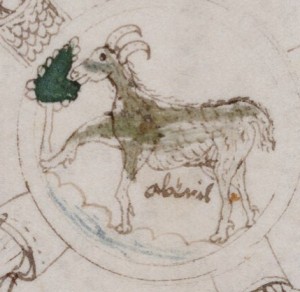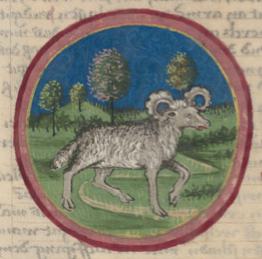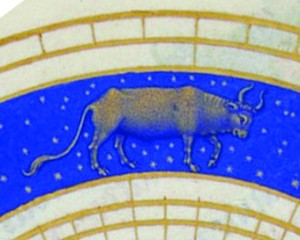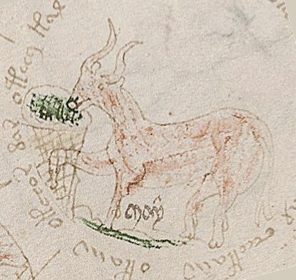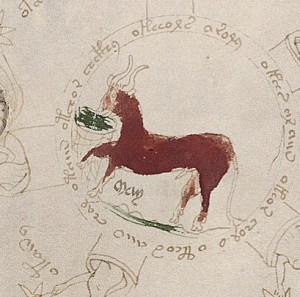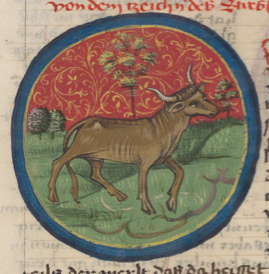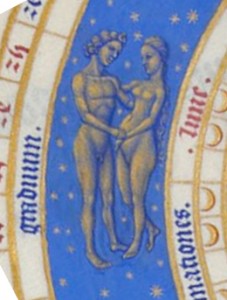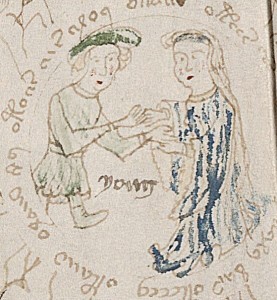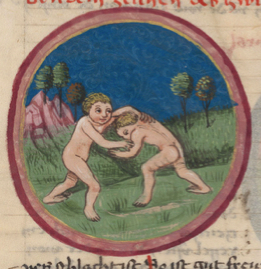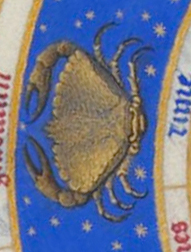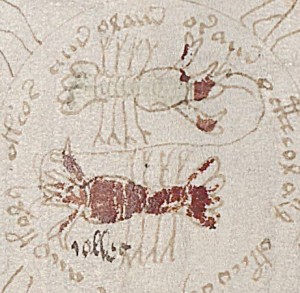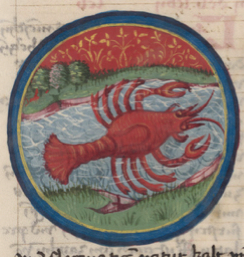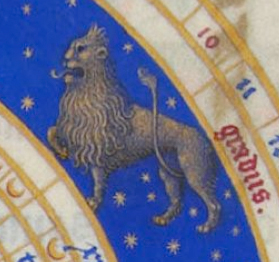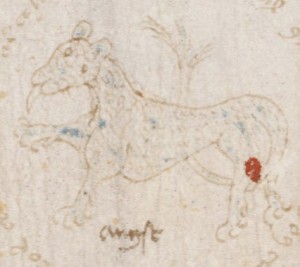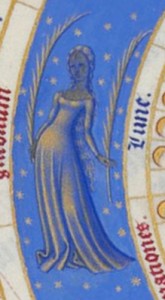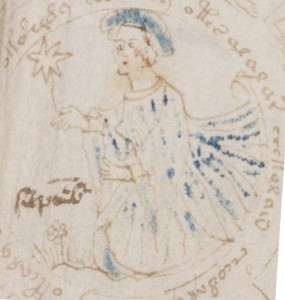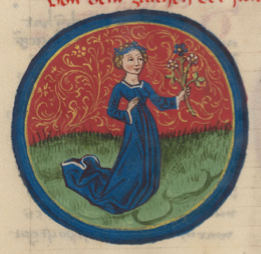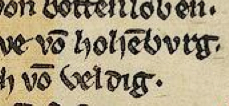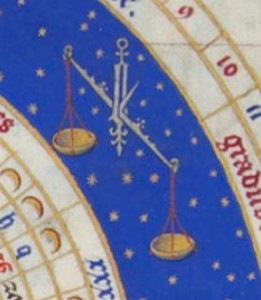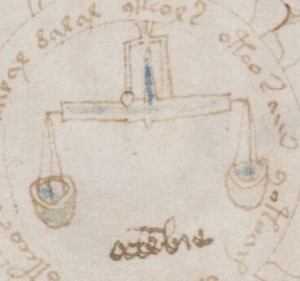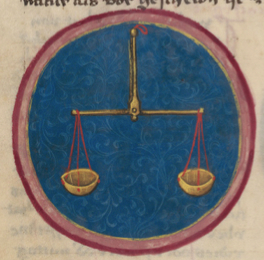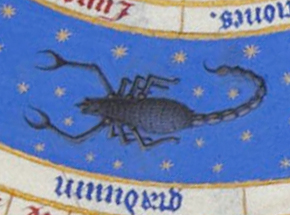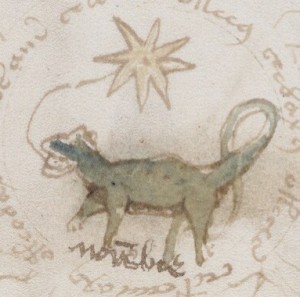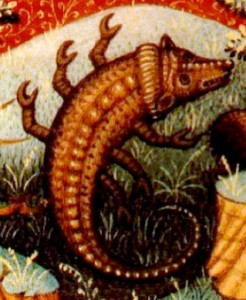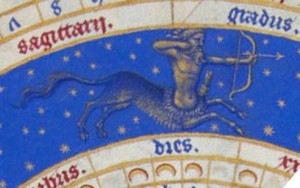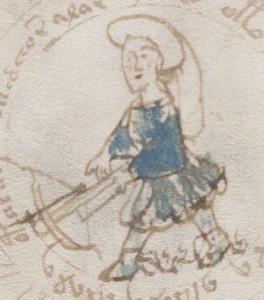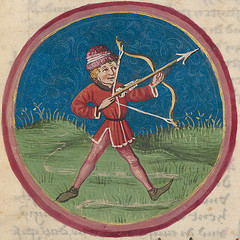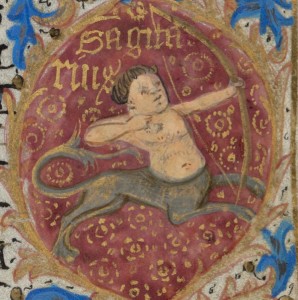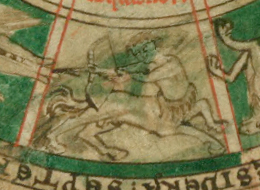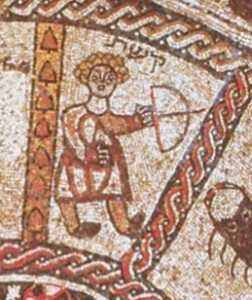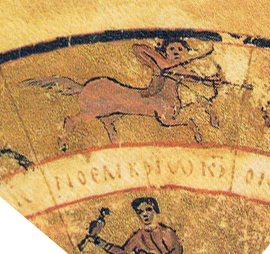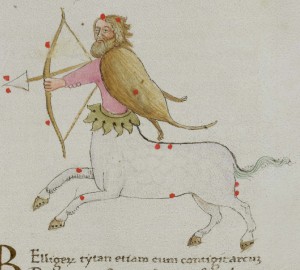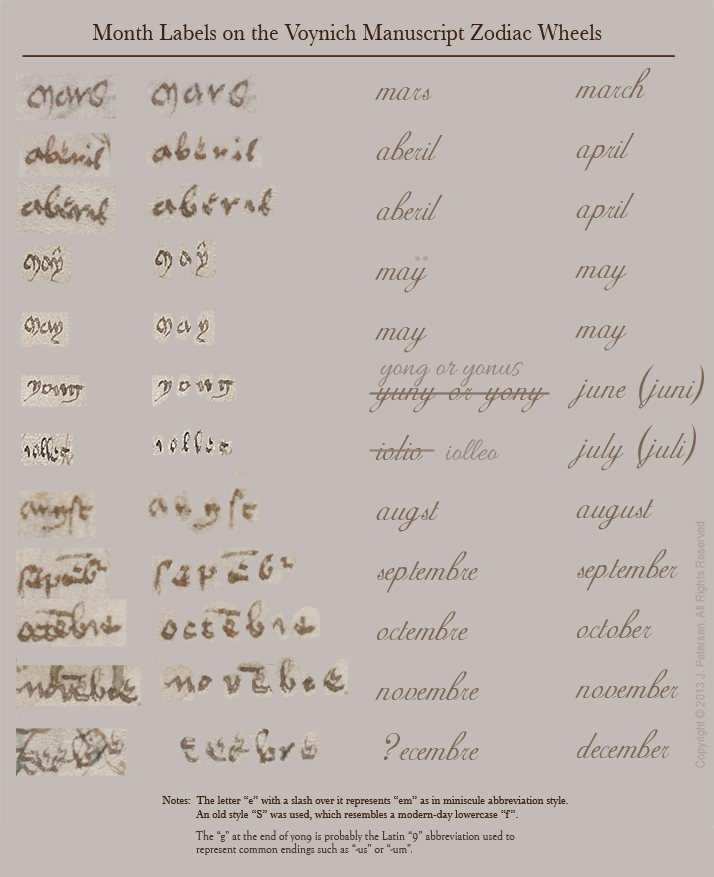The Birth and Breadth of Zodiacs
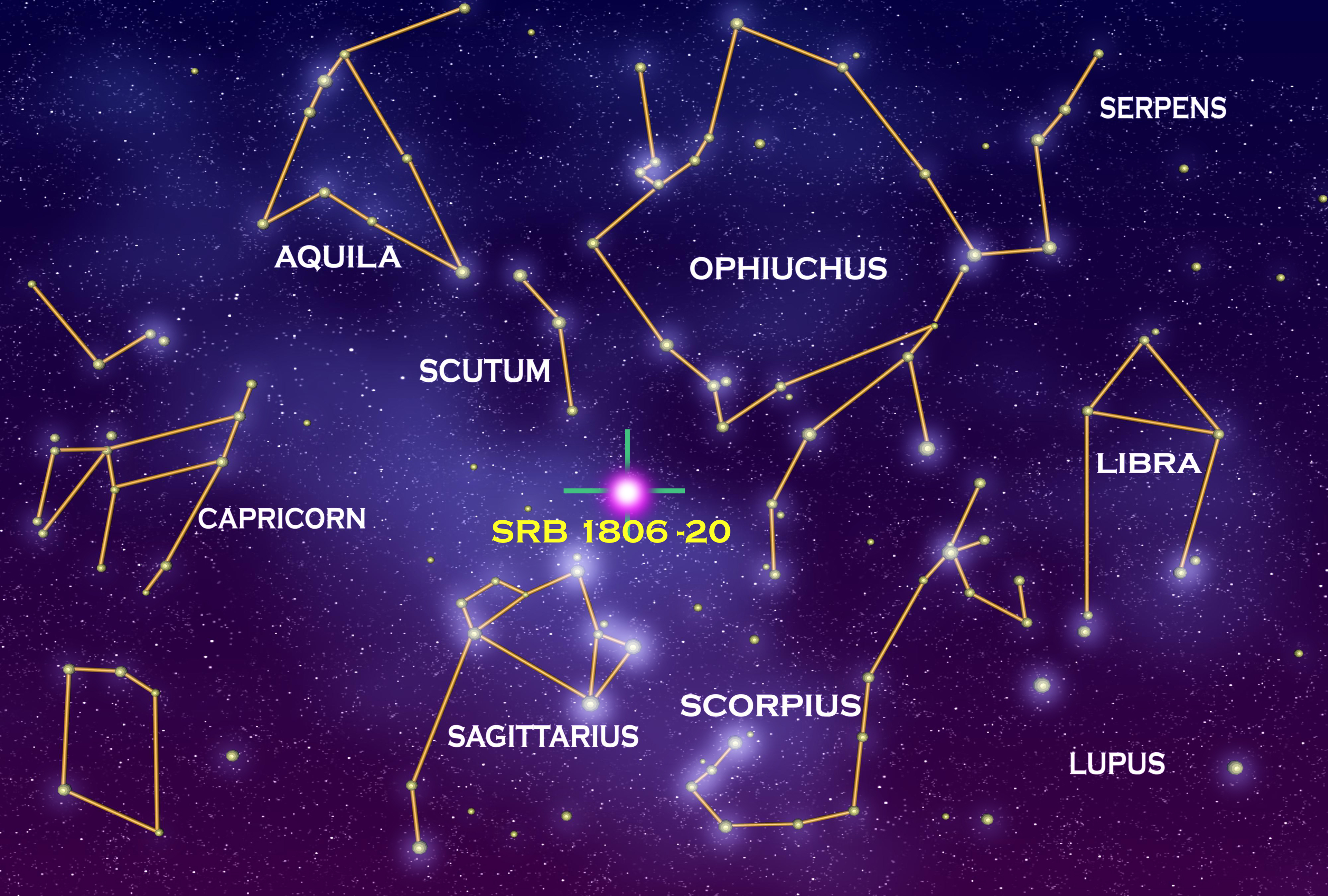
Examples of constellations, not all of which are included in the traditional 12-sign zodiac. Courtesy of NASA.
The zodiac, the twelve symbols we associate with astrology, evolved from a mixture of ancient astronomy and myth. Familiar star clusters, which came to be seen as animals, heroic figures, and deities, helped the ancients anticipate the seasons and navigate on land and sea. Celestial events, like comets and eclipses, were taken as portents of events to come.
Both eastern and western zodiacs are divided into twelve segments. Since there are far more than twelve constellations and they do not appear for equal amounts of time, this division into twelve was probably based on lunar cycles. This article will concentrate on western zodiacs, rather than those associated with China, because the Voynich Manuscript includes ten of the twelve western astrological signs.
Ancient Origins
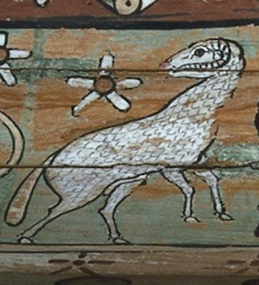
Symbol for Aries on a 2nd century Egyptian coffin that includes the twelve zodiac symbols we are familiar with today. The artifact is housed in the British Museum.
Diagrams of the constellations go back thousands of years. The ancient Egyptians adorned their temples with many astronomical and astrological references, but they assigned personalities to several of the constellations that were different from those of the Babylonians and Sumerians. The Nabatean zodiac in Petra also differs from the modern form both in the order in which the signs are presented and in some of the individual signs, which represent gods rather than animals.
Astrological concepts that developed in Chaldea, Babylonia, and S.E. Syria in the millennia preceding Christianity formed the basis for the zodiac we know today and were transmitted to Egypt through Persian incursions across the Mediterranean in the 6th century BCE and the rise of Greco-Roman cultures. While some of the ancient Egyptian astronomical concepts remained, astrological symbology changed. By the 2nd century CE, modern iconography was showing up on Egyptian coffins (upper left) and the old gods were no longer prominent as zodiac symbols.
Thus, the earliest pictorial representations of contemporary western zodiac symbols can be seen in
- Greco-Roman temple mosaics and frescoes, such as Hathor and Esneh,
- Mithraic temple sculptures and Roman coins and works of art, and
- Jewish temple mosiacs.
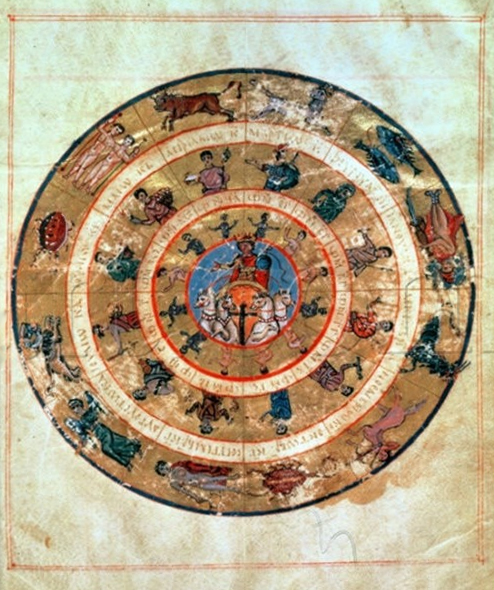
A 9th century interpretation of Ptolemy’s zodiac from Constantinople, now housed in the Vatican library.
Unfortunately, it’s difficult to assess the impact of astrological writings stored in the research institution and library at Alexandria because it was largely destroyed in the Roman conquest of Egypt in the 1st century BCE.
It’s also difficult to chart the influence of Ptolemy’s Almagest and handbook that included a zodiac, as an original copy of the manuscript no longer exists, but Mithraic symbolism had reached as far as England by the 2nd century and reproductions of Ptolemy’s works began to circulate a few centuries later. Astronomer Theodore Meliteniodes (c. 1320–1393), of Constantinople, dedicated his second book to Ptolemaic concepts.
Earliest References
Flavius Josephus (37–c.100 CE), a Jewish scholar who became a Roman citizen, reported that there was a Babylonian curtain before the doors of the Temple of Ierusalem decorated with a pictorial representation of the elements and images of the heavens (possibly constellations) but specifically remarks that it lacked the [twelve] signs. This might indicate that he was familiar with and would have expected zodiac or month signs to be included. Unfortunately, we have no way to confirm this interpretation of his words or to see the curtain for ourselves—fragile relics rarely survive to tell their tales. Most of what we know about ancient zodiacs is recorded in ceramic and stone.
earlier The Denderah Zodiac. The Denderah sky chart, one of the earliest and most complete examples of a modern zodiac cycle, was found in the ceiling of the Temple of Hathor in Egypt. Many of its early investigators jumped to the conclusion that the organization of the constellations was intended to represent the date at which it was created and projected it to two or three millennia BCE (and sometimes even older) based on astronomical calculations. They failed to consider that artistic choices may have influenced the proximity and orientation of the figures and that the architecture and inscriptions of this and two other nearby temples are clearly Greco-Roman. A more rational estimate, based on a broader base of observations, is that the Denderah temple originated around the 1st century BCE.
In the following Denderah star chart, I have lightened the background and highlighted the figures so it is easier to see the zodiac symbols. Virgo is shown on the left and is possibly depicted twice, once touching Libra, the scales, and again holding a sheaf of grain (it’s also possible there is an intervening constellation of an Egyptian god but it’s worth noting that Virgo is sometimes duplicated in later depictions, both standing alone and holding the scales).
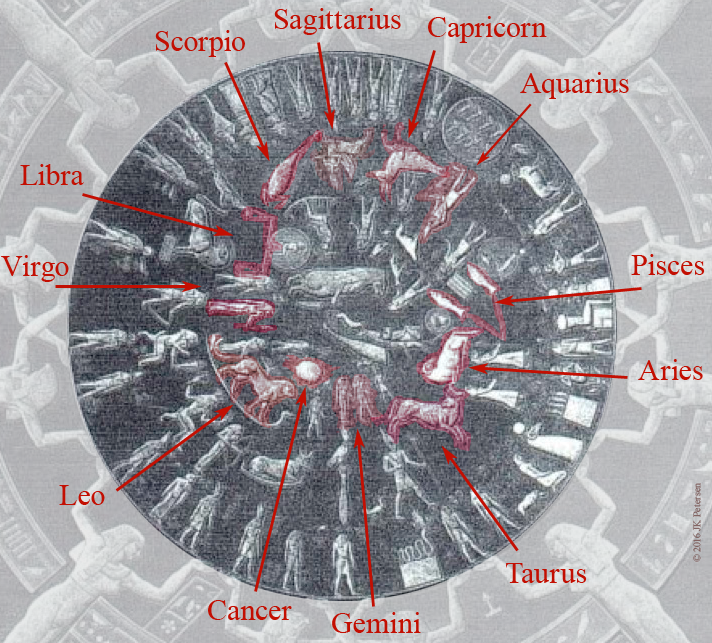 Even though it is one of the oldest remaining examples of modern astrological symbols, the Denderah zodiac is probably not the most influential in terms of spreading the iconography to other regions. Roman soldiers were the primary influence, and the Jewish diaspora contributed, as well.
Even though it is one of the oldest remaining examples of modern astrological symbols, the Denderah zodiac is probably not the most influential in terms of spreading the iconography to other regions. Roman soldiers were the primary influence, and the Jewish diaspora contributed, as well.
Manāsa 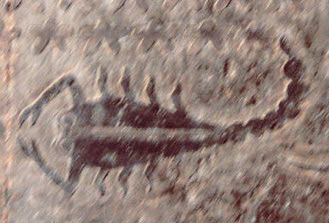 The Esneh Zodiac. The Greco-Roman Temple of Khonsu at Esneh (Ta-Esna), not far from the Denderah site, dates to approximately the time of Adrian (Emperor Hadrian), though construction and renovation occurred over a couple of centuries until it ceased around 250 CE. Ancient Egyptian influence can be seen in the style of both the Esneh and Denderah carvings (particularly the clothing, orientation of figures, and scarab-like representation of Cancer), but the astrological symbols are of the Chaldean/Babylonian form of modern zodiacs.
The Esneh Zodiac. The Greco-Roman Temple of Khonsu at Esneh (Ta-Esna), not far from the Denderah site, dates to approximately the time of Adrian (Emperor Hadrian), though construction and renovation occurred over a couple of centuries until it ceased around 250 CE. Ancient Egyptian influence can be seen in the style of both the Esneh and Denderah carvings (particularly the clothing, orientation of figures, and scarab-like representation of Cancer), but the astrological symbols are of the Chaldean/Babylonian form of modern zodiacs.
A distinctively contemporary-looking zodiac was created in Tunis during the Imperial Roman era and is now on exhibit at the Bardo Museum, and a village on a Greek island sports a c. 5th century zodiac mosaic that demonstrates that astrological concepts and reverence spread to even tiny remote communities.
Mithraic Astrological Imagery
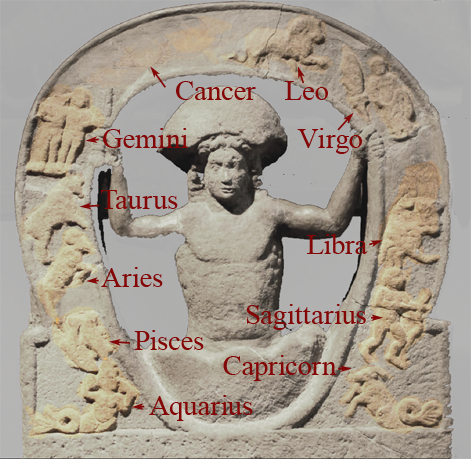 The Mithraic belief system predated Christianity, and played a role in spreading the concept of the twelve signs. Mithraism developed in Persia and the Mediterranean (and may have been inspired in part by the Indian/Zoroastrian god Mithra), but Roman soldiers developed their own version with some distinct differences from eastern iconography.
The Mithraic belief system predated Christianity, and played a role in spreading the concept of the twelve signs. Mithraism developed in Persia and the Mediterranean (and may have been inspired in part by the Indian/Zoroastrian god Mithra), but Roman soldiers developed their own version with some distinct differences from eastern iconography.
The personification of Mithras (right), rising from the ground, or possibly from an egg, is commonly shown slaying a bull. It has been suggested the Roman Mithra may have been inspired by the constellation Perseus, a warrior figure located between Aries and Taurus in the northern hemisphere, or perhaps by one of the older gods that represented war and was associated with bulls. The slaying of the bull may even have been a symbolic nod to the astronomical precession from Taurus to Aries.
Dispersion Through Roman Soldiers
The only way the Romans could maintain their supremacy and expand their territories was to deploy soldiers to new regions. As they traveled, they took their belief systems, their crafts, and their coins with them.
It’s not surprising that there are early Mithraic zodiacs on the island of Ponza, in Ostia, and Rome (where politicians in high positions were members as well), but a sandstone relief has been found in Croatia, and many of the most significant Mithraic artifacts, dating to about the 2nd century CE, are in Germany, Bohemia, and northern Italy.
The egg-shaped zodiac surrounding Mithra above right is from Hadrian’s Wall in Housesteads, England, and is now in the Great North/Hancock Museum along with a Mithraic tauroctony sculpture. The oval one to the left may represent Kronos rather than Mithra, but it too is ringed by a zodiac.
It’s said that Mithraism was a secret society, but given the number of temples and artifacts that survive, I doubt it was any more secret than the Masons are today. What went on inside closed doors may have been kept hidden, but general knowledge of the constellations was not secret knowledge. Astrological prognostication was, at times, a profitable business, and medical and judicial applications of astrology were common, so the subject of the signs no doubt came up in conversation. Despite the fact that Mithraic gathering places were deliberately destroyed in the rise of Christianity, more than 500 Mithraic temples are known and there may be others waiting to be rediscovered. Mithraic artifacts number in the thousands.
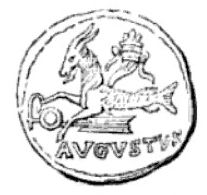 Not all Roman soldiers belonged to Mithraic societies, which included initiation rites (most still worshipped Pagan deities and mercenaries brought along their own belief systems), but the Pagans embraced astrology, as well. For example, the Roman Second Legion, based in Wales early in the 2nd century, chose Capricorn, the “sea goat”, a sign dedicated to Emperor Augustus, as one of their emblems. Zodiac symbols were also minted onto Roman coins (right), most notably Libra, Taurus, Virgo, and Capricorn. They were also widely impressed into seals, gems, and decorative ceramics (examples can be seen in the British Library collection).
Not all Roman soldiers belonged to Mithraic societies, which included initiation rites (most still worshipped Pagan deities and mercenaries brought along their own belief systems), but the Pagans embraced astrology, as well. For example, the Roman Second Legion, based in Wales early in the 2nd century, chose Capricorn, the “sea goat”, a sign dedicated to Emperor Augustus, as one of their emblems. Zodiac symbols were also minted onto Roman coins (right), most notably Libra, Taurus, Virgo, and Capricorn. They were also widely impressed into seals, gems, and decorative ceramics (examples can be seen in the British Library collection).
By the 4th century, as the Empire faded and Christianity expanded, the Mithraic movement became all but extinct, but the custom of creating zodiac mosaics spread to Jewish synagogues and showed up around the necks of statues of Artemis. Despite objections by certain church officials who condemned astrology as a Pagan tradition, the carving of stone zodiacs into sacred portals spread to Christian churches.
Jewish Astrological Imagery
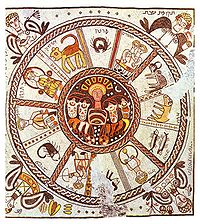 In the Talmud, the twelve constellations are associated with months of the year. Pictorial representations can be found in temple mosaics from the 3rd to 7th centuries at Beit Alpha, Beit She’an, Hamat Tiberius National Park, and Sepphoris.
In the Talmud, the twelve constellations are associated with months of the year. Pictorial representations can be found in temple mosaics from the 3rd to 7th centuries at Beit Alpha, Beit She’an, Hamat Tiberius National Park, and Sepphoris.
Even though Beit Alpha and Beit She’an are near one another, their zodiacs aren’t identical.
Unfortunately, many of the tiles are missing from the Sepphoris site, so it’s difficult to compare the imagery among all three sites, but the Beit She’an Sagittarius is a centaur, while the Beit Alpha Sagittarius has human legs. It should be noted that both Virgo and Libra are often male in some of the early eastern zodiacs, but sometimes Virgo is female, reflecting the Pagan worship of goddesses. In the Beit Alpha mosaic on the right, Virgo is shown as female next to Libra as male (the Hamat Tiberias zodiac is female and male, as well). One other difference is the presence or absence of clothing, Some of the Hamat Tiberius figures are nude, as in the Pagan style, while figures at the other sites are clothed.
Christian zodiacs often represent Virgo as female in honor of Virgin Mary while still retaining a male image for Libra. In some, the scales are alone or shown only with a hand (which later came to represent the hand of God).
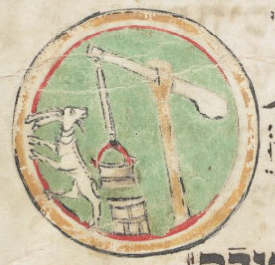
A goat by a bucket or well can represent both Capricorn and Aquarius, as in this mid-13th century Jewish Mahzor from the Bodleian Library.
One interesting detail in the evolution of zodiacs in Hebrew manuscripts is the change in the symbol for Capricorn.
In the Hamat Tiberias mosaic, Capricorn is a traditional sea-goat, as in the Roman zodiacs, but by the Middle Ages, it was common for Capricorn to be shown as a goat standing by a bucket or a well, a symbol that could stand for both Capricorn and Aquarius.
Outside the Jewish community, Capricorn as a sea-goat remained popular, although sometimes the Roman fish-tail morphed into a shell or a dragon tail.
In the Arab world, court astrologers, some of whom were Jewish, are known to have existed in the 7th and 8th centuries, and books on astrology were written not long after, but zodiac imagery of the modern form didn’t show up in Arabic manuscripts until around the 9th century. They differed from most earlier zodiacs in that they included the location of the stars (shown as dots on the animal or figure that represented the sign), which indicates their interest in astronomy.
I’ll be describing details of some of the other zodiac symbols and their relationship to the Voynich Manuscript in subsequent articles as I have far too much information to include in one blog.
Continued Interest in Subsequent Ages
In the 9th century, zodiacs were included in astronomical texts in France, Germany, and Switzerland (examples include Harley 647, the Leiden Aratea, and AN IV 18). Some of the imagery from this time period still had a distinctly Greco-Roman flavor, with figures that were nude or dressed in scanty togas. By the late 990s, the dots to indicate the astronomical aspect of the signs were included, as well.
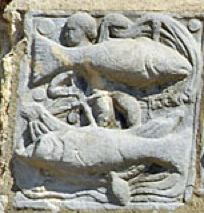
Pisces carved into the Basilica de San Isidoro in Leon. Courtesy of ParadoxPlace.
The efforts of certain Christian clergy to suppress astrology failed and the custom of carving zodiacs into the portals of sacred gathering places became particularly popular in France and northern Spain in the 11th century. Cathedral builders across Europe began adding zodiacs to their tiled floors and stained-glass windows. Labors of the month often accompanied the twelve signs, as well
Zodiac imagery was enlivening Psalters and formerly dull calendrical manuscripts by the 12th century (and were particularly popular in the 14th and 15th centuries). Interest in the twelve signs continues today.
Summary
To give a visual sense of how the earliest astrological symbols that directly influenced contemporary zodiacs spread to the outer reaches of the Roman Empire by about the 3rd century, I have created a chart using a Johnson map with a sample selection of historic sites where these items were created or located. Note, it is not known for certain if the coin on the far right follows the same zodiac sequence as western zodiacs. Generally, zodiacs from Petra and eastward differ in a number of ways from Greco-Roman zodiacs.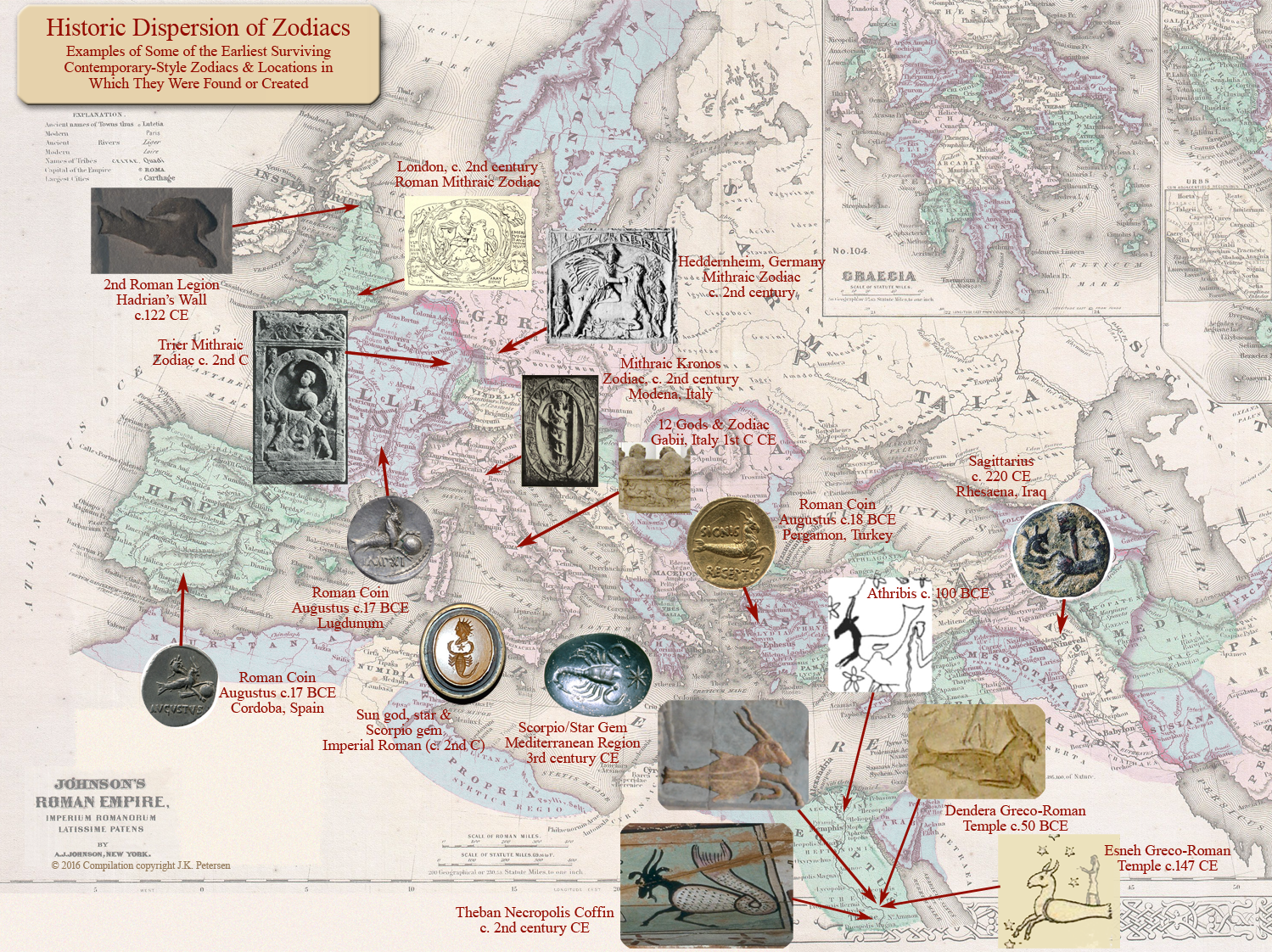 You can click on the image for a larger version and I’ll continue the discussion of VMS zodiacs in subsequent blogs.
You can click on the image for a larger version and I’ll continue the discussion of VMS zodiacs in subsequent blogs.
J.K. Petersen
© Copyright 2016 J.K. Petersen, All Rights Reserved

